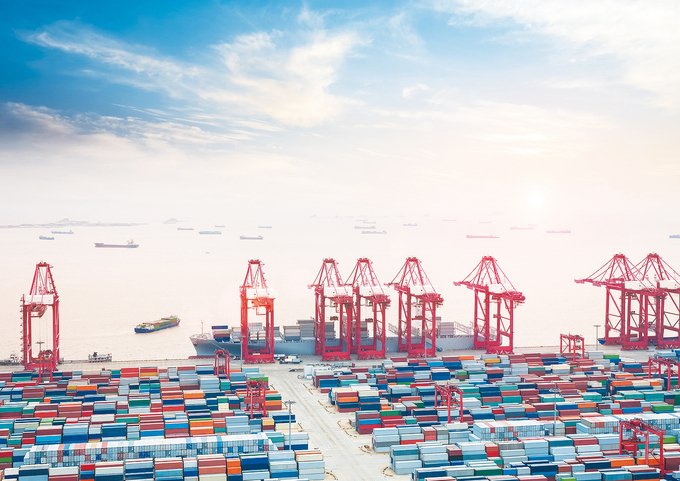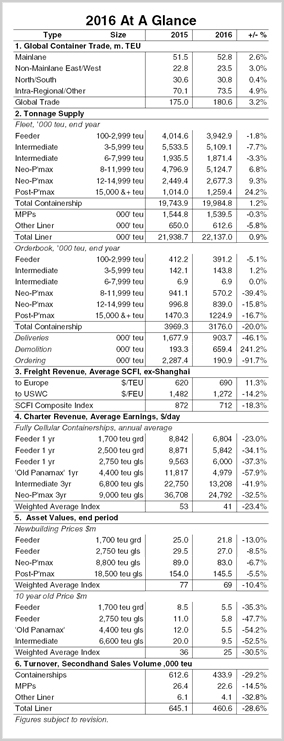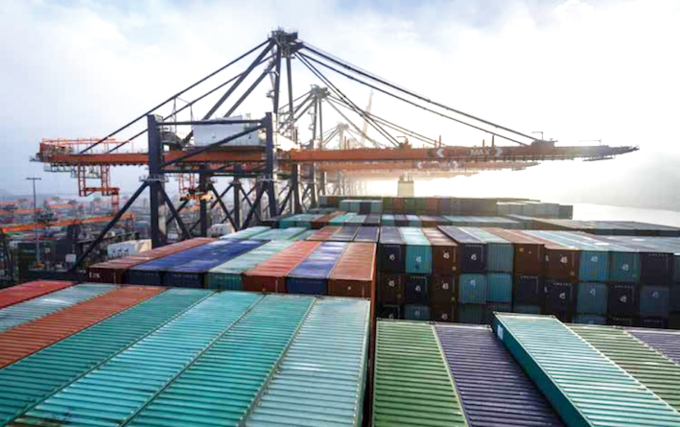
After another year of extremely difficult market conditions, many would forgive liner sector players for an air of resignation. However, despite a challenging freight market, charter rates remaining firmly in the doldrums and a major corporate casualty, looking back 2016 may well be seen as the year in which the container shipping sector really started to tackle its problems head on.
The container shipping sector has spent much of the post-financial crisis era under severe pressure and, as many expected, 2016 proved no real exception. Box freight rates in general remained weak, and the SCFI Composite Index averaged 18% lower in 2016 than in 2015. However, by late in the year it did appear that spot freight rates might be bottoming out on some trade lanes.
 Against this backdrop, charter market vessel earnings remained extremely challenged, at bottom of the cycle levels. The one year rate for a 2750 TEU ship averaged $6,000/day in 2016, 37% lower than in 2015. ‘Old Panamax’ types fared even worse, averaging $4,979/day in 2016, 58% down on 2015, with the opening of the new locks at the Panama Canal impacting vessel deployment patterns.
Against this backdrop, charter market vessel earnings remained extremely challenged, at bottom of the cycle levels. The one year rate for a 2750 TEU ship averaged $6,000/day in 2016, 37% lower than in 2015. ‘Old Panamax’ types fared even worse, averaging $4,979/day in 2016, 58% down on 2015, with the opening of the new locks at the Panama Canal impacting vessel deployment patterns.
Nevertheless, sector fundamentals did appear a little more positive in 2016. Demand conditions improved, with global volumes expanding by an estimated 3% in the full year to 181m TEU. Volumes on the key Far East-Europe trade returned to positive growth and the rate of expansion on intra-Asian trades accelerated back to more robust levels. However North-South volumes and trade into the Middle East remained under severe pressure from the impact of diminished commodity prices, though volumes into the Indian Sub-Continent grew strongly.
Meanwhile, containership capacity growth slowed significantly in 2016, reaching just 1.2% in the full year. Deliveries fell dramatically to 0.9m TEU (from 1.7m in 2015) and demolition accelerated rapidly to a new record of 0.7m TEU.
However, given the level of surplus built up in the post-Lehman years, and in particular the impact of the delivery of substantial capacity, much of it in the form of new ‘megaships’, the improved supply-demand balance seen last year was not enough to generate any significant improvement in market conditions. At the end of 2016, around 7% of total fleet capacity stood idle. The financial collapse of major Korean operator Hanjin was a further illustration of the acute distress facing both operators and owners.
So, further recalibration still appears to be necessary to generate better markets. However, 2016 might also be seen as the year in which the sector finally started to lay real foundations for a better future. Demolition hit a new record, and financial distress and regulatory requirements are expected to drive further recycling. The ordering of newbuild capacity dropped to just 0.2m TEU in 2016, a dramatic halt.
Meanwhile, further significant steps in the consolidation of the sector were taken in the form of merger and acquisition activity involving major operators; the top 10 now deploy 70% of all boxship capacity, a figure set to rise to around 80%. Building blocks only these factors may be, but many will hope that at last container shipping is starting to build towards something more positive than the gloomy conditions that perpetuated in 2016.

















